2 stable releases
| 1.1.1 | Nov 18, 2023 |
|---|---|
| 1.1.0 | Nov 2, 2023 |
#12 in #hsl
3MB
918 lines
KolorWheel.rs
What is it?
This crate is designed to make it easy to create palettes for GUI applications.
With a slightly different API, for a slightly different platform: KolorWheel.js
The way of creating a palette is to specify a base color and some parameters that modifies the H, S, L values in the given spin mode and steps.
Thanks to H2CO3 for review and support!
The HSL color model
In HSL color model, colors are defined by Hue, Saturation and Lightness.
Hue is a circular dimension, 0° is red, 180° is cyan, and 360° is also red.
Saturation goes from 0 to 100%, 0 is gray, 100% is the full color.
Lightness also goes from 0 to 100%, 0 is black, 100% is white.
Note that HSL color space is not linear.
- The closer the saturation is to zero, the less effect the hue has.
- If the saturation is 0, the hue is meaningless.
- The farther the lightness is from 50%, the less effect hue and saturation have.
- If the lightness is 0 or 100%, hue and saturation have no effect at all.
- Not all value triples are different colors, but different colors have different values.
Also note,
converting a HSL value to RGB is trivial,
but converting RGB to HSL is not.
For example, #000000 (black) color has
zero lightness, but
hue and saturation can be anything.
The flaws of the HSL color model
The HSL model does not represent how human vision actually works.
Linear changes in H, S, L values may not perceived linearly by the human eye.
See also
- Pastel: a nice command-line tool to generate, analyze, convert and manipulate colors
- Kolorwheel.js documentation: some docs and ideas
Quick API overview
Step 1: create the KolorWheel object
with base color and number of steps:
let base_color = HslColor::new(0, 100, 40);
let mut kw = KolorWheel::new(base_color, 10);
Step 2: define H/S/L absolute or relative changes:
kw.with_hue(SpinMode::Absolute(120));
kw.with_saturation(SpinMode::RelativeIncl(-15));
Step 3: optionally, on top of absolute/relative changes, offset array slices can be specified:
kw.with_lightness(SpinMode::Offset(&[0, 15, 30]));
Step 4: optionally, the result can be forked, so each result item produces a separate series of colors using item color as base color, only the size of sub-series should be specified:
kw.fork(5);
kw.with_hue(SpinMode::RelativeIncl(45));
The number of overall items will be the product of original and forked counts (in this example: 10 * 5 = 50);
Step 5: the result can be get via iterator.
The item type is HslColor,
which can be transformed to RgbColor:
for hsl_color in kw {
let rgb_color: RgbColor = hsl_color.into();
//...
}
API details
Create KolorWheel object
KolorWheel::new<T>(color: T, count: usize) -> Self
Creates a KolorWheel object
with base parameters:
color: base color, should beHslColoror any type which implementsInto<HslColor>.count: number of steps of color transformation, including initial state.
Returns KolorWheel object,
which must be declared as mutable.
Spin the wheel
These methods apply specified SpinMode
on the KolorWheel object.
They return mutable reference for chaining.
with_hue(&mut self, spin_mode: SpinMode) -> &mut KolorWheelwith_saturation(&mut self, spin_mode: SpinMode) -> &mut KolorWheelwith_lightness(&mut self, spin_mode: SpinMode) -> &mut KolorWheel
The SpinMode enum lists the possible spin
operations.
Valid ranges for hue is 0 to 360°, but upon overflow or underflow, it will be normalized, e.g. 365° -> 5° or -10° -> 350°.
The saturation and lightness must be between 0 and 100%. Upon overflow or underflow, they will be cut, e.g. 99% + 5% -> 100% or 10% - 25% = 0.
The API uses i32 for degree and percent values.
pub enum SpinMode<'m> {
Still,
Absolute(i32),
RelativeIncl(i32),
RelativeExcl(i32),
Offset(&'m [i32]),
}
Still: defult value for no change, may not be used in API calls.Absolute: set absolute target value.RelativeIncl: set relative target value. the target value will be included in the result.RelativeIncl: set relative target value, the target value will be excluded from the result. It's useful when the created palette is circular, the real target is the next round's first color, so the last color should be one step back.Offset: defines a list, which offsets the result. If the offset size is less than spin size, offsets will repeat.
A H/S/L component may have optionally one of
Absolute, RelativeIncl and RelativeExcl,
and optionally one Offset specified.
Spin macros
This method applies specified SpinMacro
on the KolorWheel object.
It returns mutable reference for chaining.
with_macro(&mut self, spin_macro: SpinMacro) -> &mut Self
SpinMacro transformations are shourtcuts
to common ones,
they are implemented with SpinMode under the hood.
pub enum SpinMacro {
GradientColor(HslColor),
FadeToGray(i32),
FadeToBlack,
FadeToWhite,
}
GradientColor: simple gradient, shorthand for setting absolute transformations for H, S and L. Target color should beHslColor, or any type which implementsInto<HslColor>.FadeToGray: shorthand for transforming saturation to zero, and lightness to the specified value, aka. gray level.FadeToBlack: special case forFadeToGray, with lightness value of 0.FadeToWhite: special case forFadeToGray, with lightness value of 100%.
Forking
Creates a new spinner for each result, with results as base colors.
fork(&mut self, count: usize) -> &mut Self
count: the number of steps for the inner spinner.
Returns mutable reference for chaining.
The overall steps will be the product value of
all count parameters, e.g. the initial
value in constructor,
and ones specified in fork() calls.
For example,
- create a
KolorWheelwith base color of red and 4 steps, - add transformation
SpinMode::Absoluteto blue, then - call
fork()with count of 10 and add a macro transformationSpinMacro::FadeToWhite.
What we get:
- the result's first color will be red, then
- it fades to white in 10 steps.
- The 11th color will be violet (1/4 step closer to blue), and
- it will be faded to white in 10 steps,
...and so on. The total number of results will be 4 * 10 = 40.
Result
The result can be get via iterator:
let mut kw = KolorWheel::new( ... );
...
for hsl_color in kw {
let rgb_color: RgbColor = hsl_color.into();
...
}
The result type is HslColor,
which can be converted to RgbColor
using From and Into traits:
pub struct RgbColor {
pub r: u8,
pub g: u8,
pub b: u8,
}
Examples
The examples/ directory contains
a small GUI app (using egui)
with some example panels,
which demonstrate the main functions of the library.
How to build and run the example app:
cargo run --example main
1: Gradient
The transition between two colors lacks imagination and creativity, but there's a macro for it, obviously.
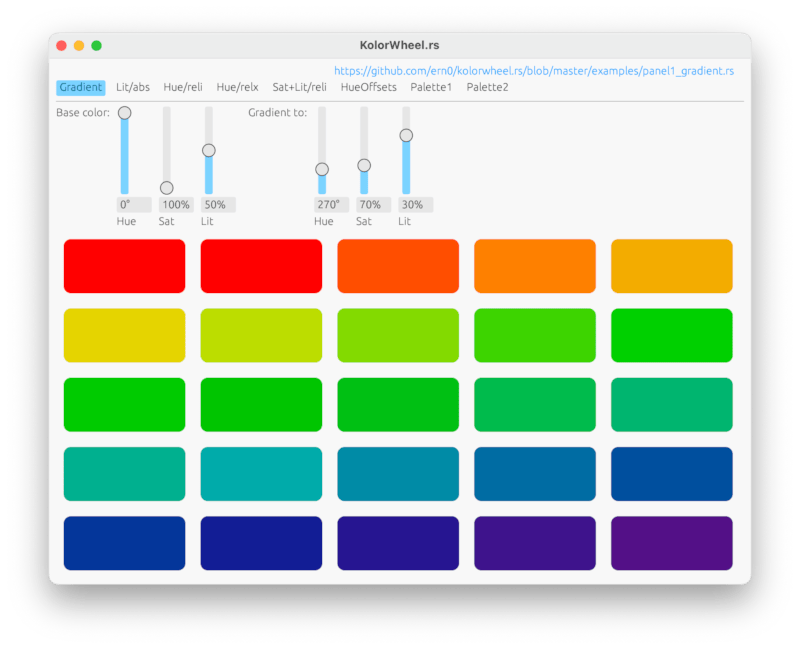
let mut kw = KolorWheel::new(self.color1, 5*5);
kw.with_macro(SpinMacro::GradientColor(self.color2));
See full example for details.
2: Lit/abs
It's common to simply darken or lighten a color by specifying a target lightness value.
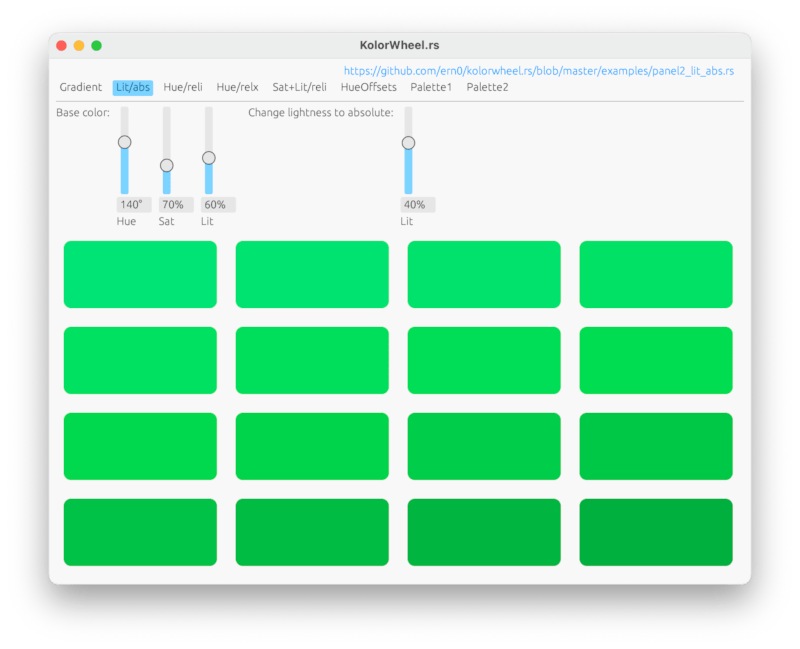
let mut kw = KolorWheel::new(self.color, 4*4);
kw.with_lightness(SpinMode::Absolute(self.lit));
See full example for details.
3-4: Hue/reli, Hue/relx
For a relative value, it is important whether the last step is included in the result, especially in case of hue transformation.
If you only display the generated palette once, the last value should be the specified one.
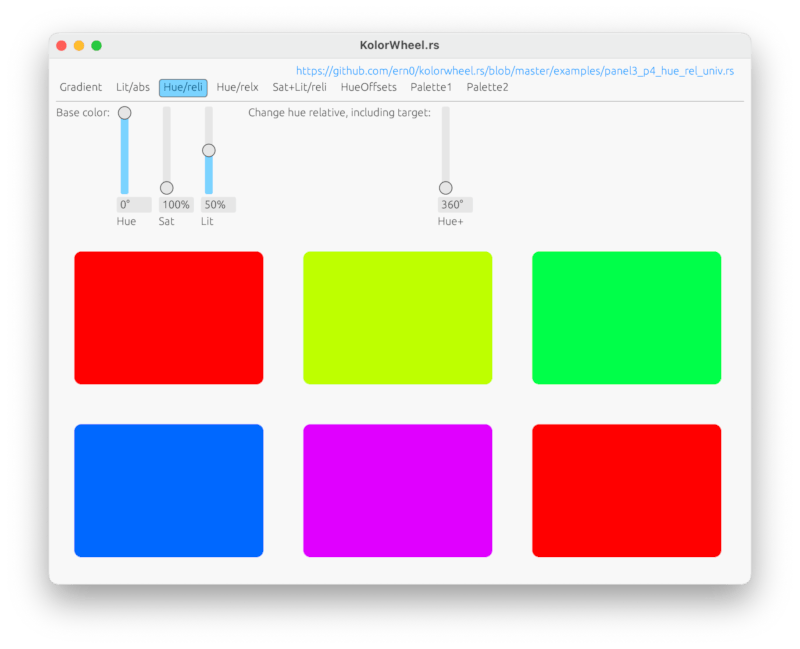
let mut kw = KolorWheel::new(self.color, 3*2);
kw.with_hue(SpinMode::RelativeIncl(self.hue));
If you display the generated palette more than once, endless or circular fashion, the last item will match the next round's first one, so it should be omitted.
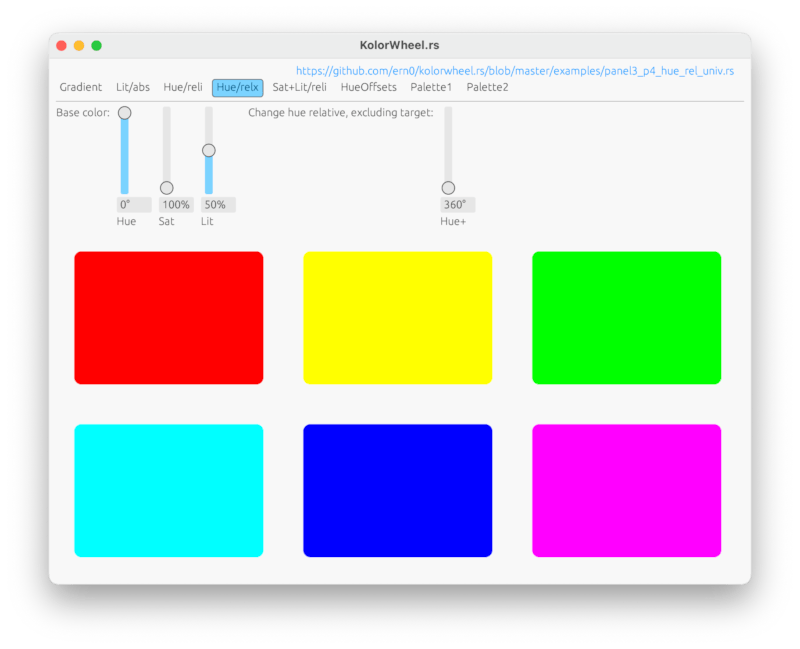
let mut kw = KolorWheel::new(self.color, 3*2);
kw.with_hue(SpinMode::RelativeExcl(self.hue));
See full example for details.
5: Sat+Lit/rel
One of the most common transformations is altering saturation and lightness together while keeping the hue unchanged.
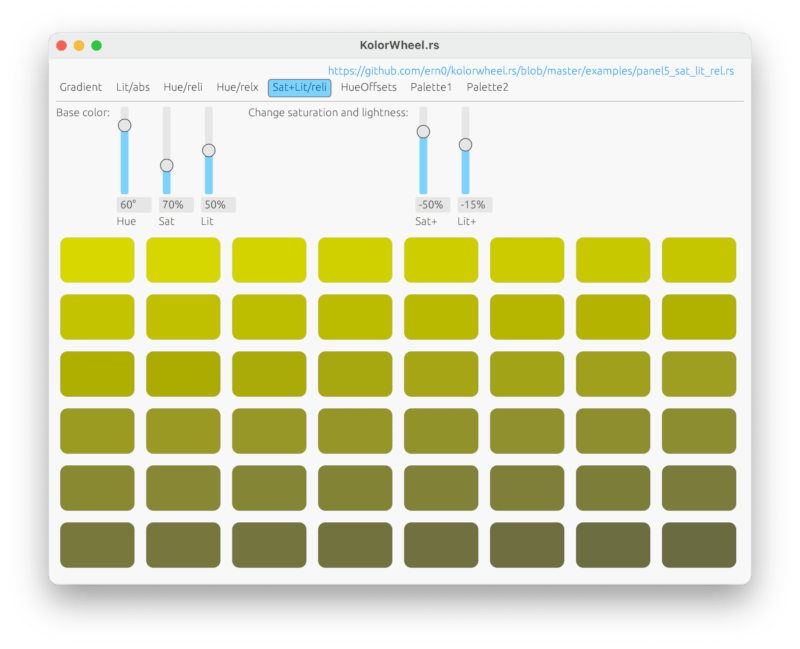
let mut kw = KolorWheel::new(self.color, 8*6);
kw.with_saturation(SpinMode::RelativeIncl(self.sat));
kw.with_lightness(SpinMode::RelativeIncl(self.lit));
See full example for details.
6: HueOffsets
On top of the calculated transformations, an array (slice) of offsets can be applied on any channel. In this example, on each item of the outer gradient, an inner transformation is applied, which is simply a series of hue offsets. You can see the outer transformation on the original hue in the first and fifth row.
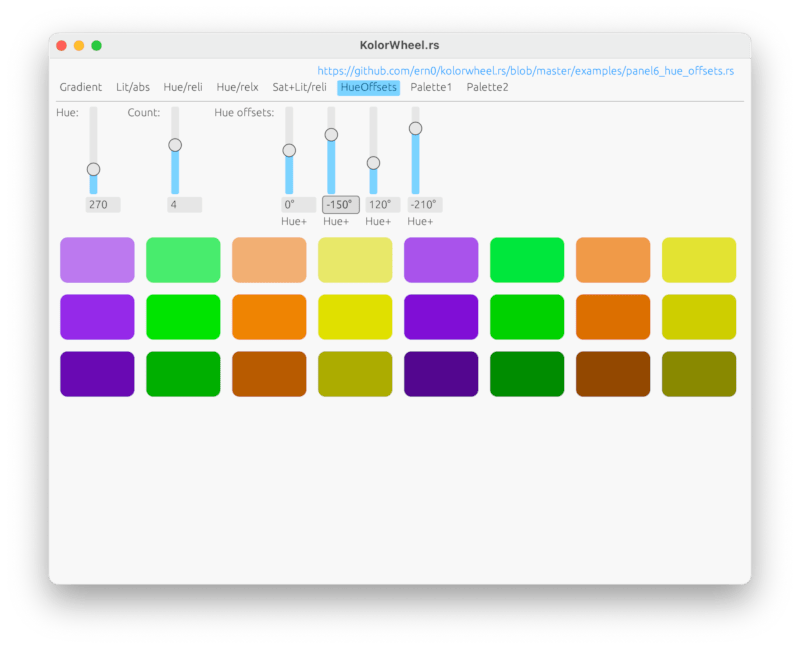
let mut kw = KolorWheel::new(self.color1, self.rows);
kw.with_macro(SpinMacro::GradientColor(self.color2));
kw.fork(self.count);
kw.with_hue(SpinMode::Offset(&self.values[0 .. self.cols]));
See full example for details.
7: Palette1
If the values are chosen carefully, calculated transformations and offseting can be used on the same channel.
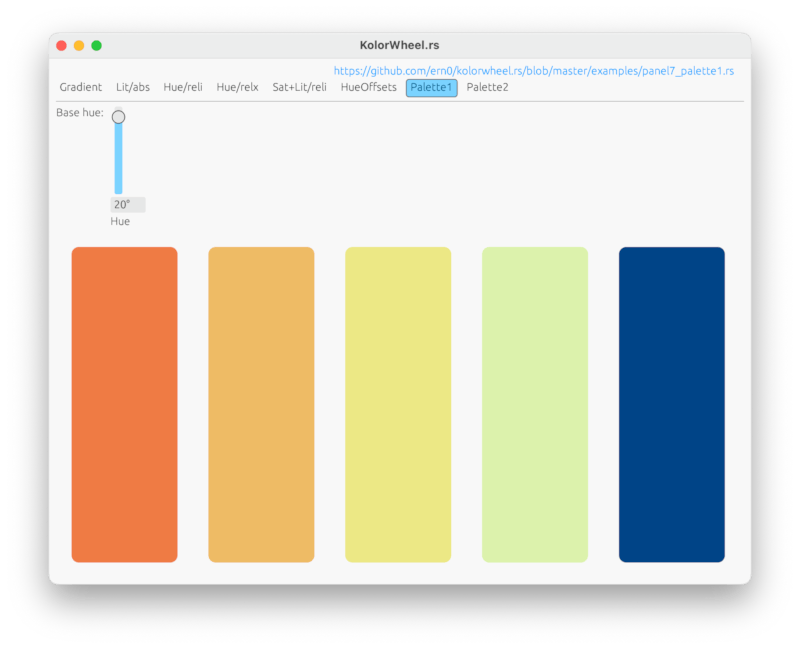
color: HslColor::new(20, 70, 60),
hue_offsets: [0, 0, 0, 0, 120],
lit_offsets: [0, 0, 0, 0, -60],
(...)
let mut kw = KolorWheel::new(self.color, 5);
kw.with_hue(SpinMode::RelativeIncl(75));
kw.with_hue(SpinMode::Offset(&self.hue_offsets[0..5]));
kw.with_lightness(SpinMode::RelativeIncl(30));
kw.with_lightness(SpinMode::Offset(&self.lit_offsets[0..5]));
See full example for details.
8: Palette2
While calculated transformations describe a base palette, offset values can be used to give specific items a function, e.g. a darker color can be used as font color.

color: HslColor::new(240, 80, 70),
sat_offsets: [60, 0, 0, 70, 0, 0],
lit_offsets: [-40, 0, 0],
(...)
let mut kw = KolorWheel::new(self.color, 3*2);
kw.with_hue(SpinMode::RelativeIncl(90));
kw.with_saturation(SpinMode::RelativeIncl(-20));
kw.with_saturation(SpinMode::Offset(&self.sat_offsets[0..6]));
kw.with_lightness(SpinMode::Offset(&self.lit_offsets[0..3]));
See full example for details.